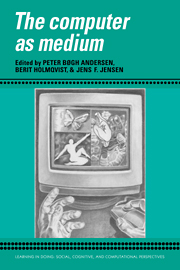Book contents
- Frontmatter
- Contents
- Series foreword
- Preface
- Contributors
- Part I Computer-based signs
- Part II The rhetoric of interactive media
- Introduction
- 6 Narrative computer systems: The dialectics of emotion and formalism
- 7 Interactive fiction: Artificial intelligence as a mode of sign production
- 8 Plays, theaters, and the art of acting in the eighteenth century: A formal analysis
- 9 The meaning of plot and narrative
- 10 Face to interface
- 11 Drawing and programming
- 12 Hypermedia communication and academic discourse: Some speculations on a future genre
- Part III Computers in context
- Index
7 - Interactive fiction: Artificial intelligence as a mode of sign production
Published online by Cambridge University Press: 05 October 2010
- Frontmatter
- Contents
- Series foreword
- Preface
- Contributors
- Part I Computer-based signs
- Part II The rhetoric of interactive media
- Introduction
- 6 Narrative computer systems: The dialectics of emotion and formalism
- 7 Interactive fiction: Artificial intelligence as a mode of sign production
- 8 Plays, theaters, and the art of acting in the eighteenth century: A formal analysis
- 9 The meaning of plot and narrative
- 10 Face to interface
- 11 Drawing and programming
- 12 Hypermedia communication and academic discourse: Some speculations on a future genre
- Part III Computers in context
- Index
Summary
The ideas presented in this chapter grew out of the authors experiences in an earlier attempt to create interactive fiction. In Chapter 6, “Narrative Computer Systems,” we describe our struggle with a short story mainly based on pictures. The first part of the story explores the graphical possibilities as means of sign production. However, when we began to work on the next part, where interaction took over as the most important means of expression, we got stuck. There were three interrelated problems:
The balance between reader and author shifts, since the reader must perform some of the functions previously allotted to the author. Who is responsible for getting a satisfactory experience out of the product? The reader or the author? What is the best balance between the two?
As a consequence of this, the length of the narrative controlled by the author is shortened, so that the author no longer plans and constructs a 300-page story. Instead, he constructs short narrative pieces that must be combinable in different ways, rather like a construction set. What should these narrative pieces look like?
How should one compose interactive fiction? We know by tradition how to write a text, but which techniques are suitable for developing a product that is not one, but many texts?
These problems are not special to our project, but are general problems of interactive media, as several researchers in the field have already pointed out. (Yellowlees Douglas, 1990; Moulthrop, 1989; Bolter & Joyce, 1987; Marshall & Irish, 1989).
- Type
- Chapter
- Information
- The Computer as Medium , pp. 169 - 185Publisher: Cambridge University PressPrint publication year: 1994



